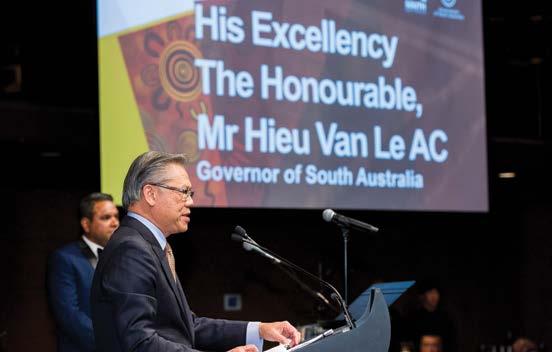
10 minute read
Inside: Celebrating the landmark 1967 Referendum
On May 27, Australia celebrated 50 years since the successful 1967 Referendum, which acknowledged Indigenous people as citizens of the nation for the first time and allowed the Federal Government to make laws specifically for Indigenous people. At a dinner hosted by the department of State Development, His Excellency the Honourable Hieu Van Le AC, Governor of South Australia and The Honourable Kyam Maher, Minister for Aboriginal Affairs reflected on the significance of the vote in ’67.
Minister Maher said that the referendum marked the beginning of a shift in the nation’s thinking. “Increasingly people began to understand that Aboriginal people ought to matter, ought to be counted,” he said. “The referendum count wasn’t just a symbolic gesture, but the symbolism of it alone was nevertheless very powerful. “It was the beginning of something which is ongoing today. The beginning of the not so radical notion that Aboriginal people are just like all people, they want to be visible not invisible and they matter,” he said.
Advertisement
Minister Maher said that the referendum paved the way for a great deal of change in South Australia and Australia more broadly. However, that change was sometimes frustratingly slow to occur. “Throughout history rights for many people have rarely be won without a fight. Just about every right that Aboriginal people have gained in this nation have been won not granted. The referendum’s resounding yes came about because of tireless advocacy by Aboriginal activists, including many South Australians,” he said.
Governor Hieu Van Le also remembered and celebrated the work of local activists for the referendum campaign.
“Many passionate and courageous Aboriginal people from South Australia or with strong connections to South Australia were active in the lead up to the 1967 referendum.
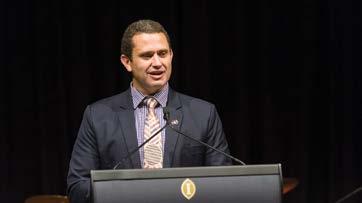
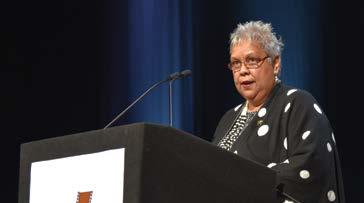
From top: The Governor at the 1967 Referendum Dinner; Mr Kyam Maher, Minister for Aboriginal Affairs; Dr Jackie Huggins at Reconciliation SA Breakfast. “The newly formed Aboriginal Women’s Council for example, was extremely influential at this time. Led by Gladys Elphick, the Council played an extremely important role lobbying for Aboriginal rights,” he said. Minister Maher spoke about the feeling that was around following the resounding Yes vote at the 1967 referendum.
“Reflections of those who were there at the time recall feelings of joy, as well as a euphoric atmosphere in communities. “It also realised the difficulty that change would not come immediately. This was just the beginning of further struggle. Many Aboriginal people faced the same discrimination, the same racism, the same inequality in education, health and employment. “Although there was a feeling of optimism that the referendum would deliver equality in the eyes of the broader Australian community, it has taken time. And while that change didn’t come quickly, the moment of the referendum gave us an unambiguous result. “We are right to celebrate how far we have come since the 67 referendum and we are right to celebrate the hard work of so many including those who are no longer with us.” Dr Jackie Huggins is the co-chair of the National Congress of Australia’s First Peoples. As a child, Jackie helped her mother hand out how to vote cards in Brisbane for the ’67 referendum,
“As a young child I saw the struggles and I saw the campaign unfold, which I still clearly remember,” she told Aboriginal Way. While politics was ‘fairly incomprehensible’ to her as a child, she knew that her mother believed in the importance of the changes to the constitution.
“My mother would always say ‘we will be free people, we will be free come the referendum’,” she said.
“I didn’t quite know what she meant until years and years later, in a sense we were free, we weren’t constrained by the flora and fauna act, we were now counted as humans in the census,” she said.
The second major change to the Constitution in ’67 was to give the Federal government power to make laws specifically for Aboriginal people. Dr Huggins believes this has had mixed benefits.
“With the right of the Commonwealth to override the states, one would think this would be a good idea, but it hasn’t turned out to be, for example in the Hindmarsh Island issue and the Racial Discrimination Act, the Commonwealth has acted to the detriment of Aboriginal and Torres Strait Islander people I think,” she said.
Overall, Dr Huggins believes that while there have been positive changes, there is still a long way to go.
“Much has changed, but much has gone at a very glacial pace. And in some areas its gone backwards. We just need to look at Close the Gap, where we’ve seen such bad outcomes. The high rates of suicide, incarceration, Aboriginal women are the fastest growing population in our country.
“There’s been good and there’s been bad but still overwhelmingly bad when 3% of the population, have such bad problems and we cannot get this fixed.
“Stakeholders and governments need to listen a lot more closely to Aboriginal and Torres Strait Islander people,” she said.
At the 1967 Referendum Dinner in Adelaide, Governor Hieu Van Le also acknowledged that there is still a great deal of work to be done in Aboriginal advancement.
“Since 1967 we have seen a large range of positive changes in the status of rights recognition of Australian Aboriginal people but we also know that there is still a great deal of work to be done.
“The task of achieving all remaining to be done cannot rest on Aboriginal people’s shoulders alone, it must be a project of the whole Australian community and society. That is true reconciliation,” he said.
SA NAIDOC Awards celebrate local achievements
South Australia has celebrated outstanding contributions by Aboriginal people in our community at the SA NAIDOC Awards, held at the Adelaide Town Hall on 3 July 2017.
From an Aunty and author who has spent her long life sharing her story of being stolen from her family, to a young athlete who played at an elite level from the age of just 16, the awards remind us of the diversity and contributions of South Australian Aboriginal people.
Doris Kartinyeri is a Ngarrindjeri woman who was stolen from her family at just one month old. She spent the first fourteen years of her life at the Colebrook Home. She has been a strong advocate for the Stolen Generation and sharing her own personal journey.
She is the author of the book Kick the Tin, which is widely used in schools and universities. Doris Kartinyeri won the Lifetime Achievement Award for 2017.
Roxanne Dodd is a league soccer player who scored 19 goals last year. She has represented at state and national level and first represented at league level at the age of 16, showing maturity and strength beyond her years. She’s continuing to develop in her sport and as a role model for young Aboriginal women and was awarded the NAIDOC SA Sportswoman of the Year Award.
The Sportsman of the Year Award was presented to Anthony Wilson, who has played football in the SANFL for Port Adelaide and Norwood, and who spent one year playing in the AFL. Presenting his award, NAIDOC SA Chair Charlene Lamont said that Anthony showed strength and resilience when he was racially vilified and that he is young person who demonstrates a never-giveup attitude.
After receiving his award, Mr Wilson said that he recognised the importance of sports people contributing to their community.
“I guess being a sports person you’re always looked up to and you see the likes of Eddie Betts and Adam Goodes and all those people who stand up and do a lot for their community.
“I’m pretty lucky to be pretty close with Eddie and have learnt a lot from him, not only about footy but as a community person as well, he’s always giving back,” he said.
Mr Wilson also works as a Program Manager with AIME, mentoring young people.
It’s really inspiring to see kids get out of their comfort zone and jump head first into something they don’t know what they are getting into, that’s what we’re all about, getting kids out there and confident in their identity,” he said.
Female Elder of the Year Award was presented to Heather Agius. She has worked tirelessly over the years advocating for her community. She volunteers in a number of roles, including with ALRM and Corrections visiting and supporting Aboriginal prisoners.
After her award was presented, Mrs Agius said that she does the work with Aboriginal youth because she loves it.
“I work in Prisons part time, talking to the lads. And I just love what I am doing, I’m helping in some way with the young lads who get into trouble.
“I’m just able to sleep at night. I’m able to see what’s happening across the country as far as imprisonment of Aboriginal people, and trying to help in some small way and trying to get the boys to change their lives,” she said.
Making change is not always easy Mrs Agius explained.
“I have had men come up to me and say they want to change, there’s still a lot of hindrances out there, not being able to get jobs, being disqualified from driver’s licence, because they don’t have any trades. So it’s really hard, we are behind the eight ball as far as moving forward with that, so trying to fix those things is a necessity,” Mrs Agius said.
Male Elder of the Year went to a face that is familiar to many due to his work in acting and on advertising campaigns, including the Yidaki and the Quit campaign – Stephen Gadlabarti Goldsmith. Mr Goldsmith was recognised for his kind and open sharing of his cultural knowledge and his work in reviving the Kaurna language.
Scholar of the Year was presented to Professor James Ward, a researcher and academic who is well known around the country for his strong stance in closing the gap and improving Aboriginal health outcomes.
Artist of the Year is James Tylor, who practices in experimental photographic practices. He uses a hybrid of analogue and digital photographic techniques to create contemporary art works that are generating interest across the country.
Zancott Recruitment was recognised as 2017 NAIDOC Business of the Year.
The inaugural NAIDOC SA Caring for Country award was presented to a regional Landcare facilitator from the APY lands pastoral program – Walter Tjami.
Young person of the Year was awarded to Kyren Dixon, a polite and respectful young man who has played football for Port Adelaide and completed a degree.
The 2017 NAIDOC person of the Year is Paul Vandenbergh, Director of Aboriginal Programs at Port Adelaide Football Club.
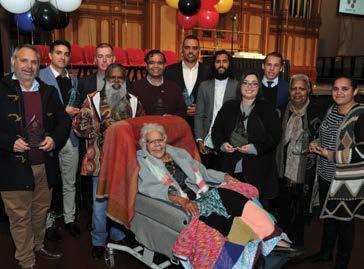
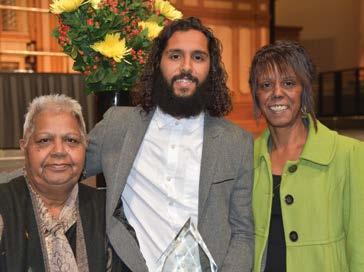
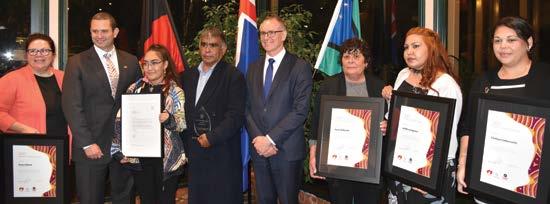
Top to bottom: All recipients of 2017 SA NAIDOC Awards; Heather Agius, Anthonny Wilson and Winnie Warrior; All recipients of 2017 Premier’s NAIDOC Awards, pictured with the Premier and Minister for Aboriginal Affairs. Mr Frank Wanganeen was the recipient of the 2017 Premier’s NAIDOC Award.
He was recognised for his outstanding contribution to Kaurna language revival and reconciliation through cultural education.
Student Tayla Karpany was recipient of the inaugural Dr Alice Rigney Prize.
Other finalists were: Judith Lovegrove, Irene McKenzie, Chelsea Lieberwirth and Karen Glover.
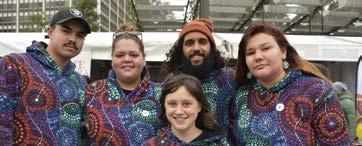
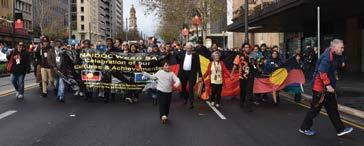
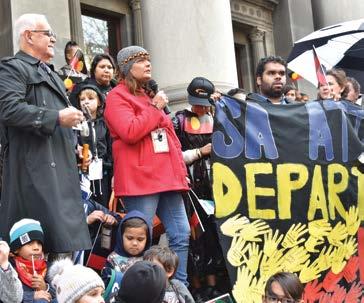
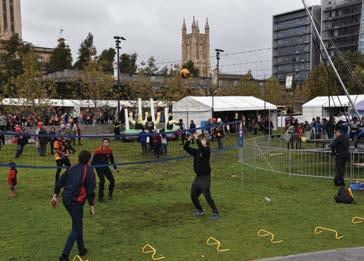
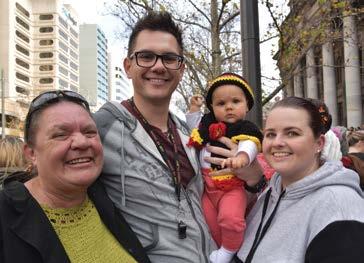
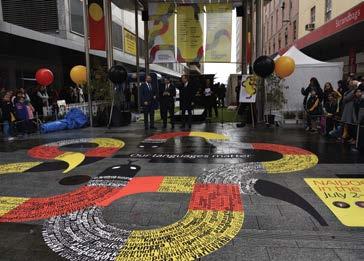

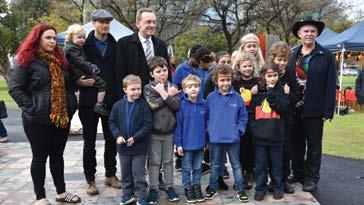
This page, from top left, clockwise: Tyrell Sinclair, Rhian Miller, Selina Miller, Anthony Wilson, Echo Soldier Wolf, AIME; NAIDOC SA Chair Ms Scharlene Lamont addresses crowd after NAIDOC March; NAIDOC family fun day; NAIDOC comes to the Mall; Students from Challa Gardens & Gilles Street Primary School, artists Jacob Logos and Taylor Power Smith, Ivan Copley and Lord Mayor Martin Haese at a new artwork unveiled at Reconciliation Plaza at Tarntanyangga/ Victoria Square; (left to right) Simone Ulalka Tur, Natalie Harkin, Ivan-Tiwu Copley, Taylor Power-Smith, Katrina Ngaitlyala Power; Family at the SA NAIDOC March; Jeremy Bilney, Joan Bilney, Tilly Coulthard at NAIDOC March; 2017 SA NAIDOC March; 2017 SA NAIDOC March.




